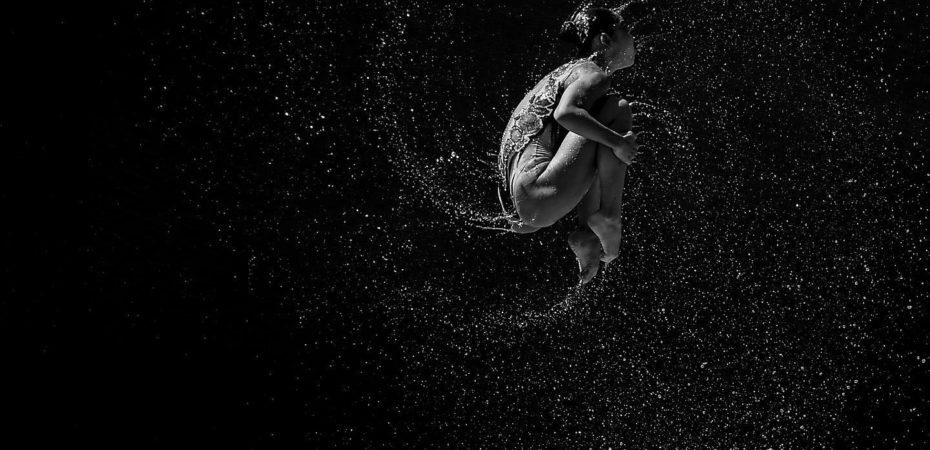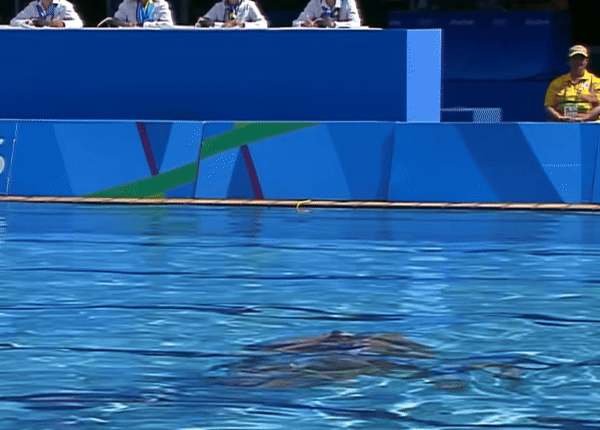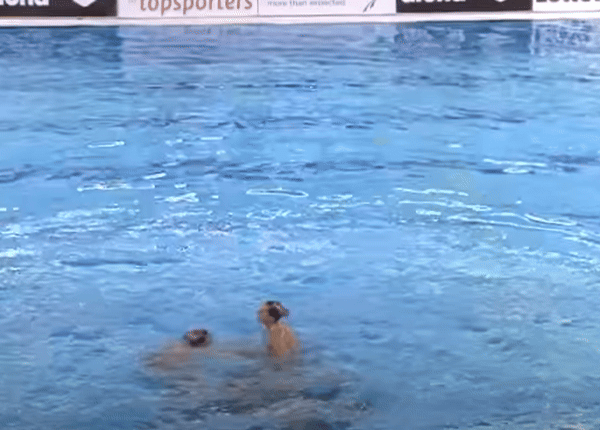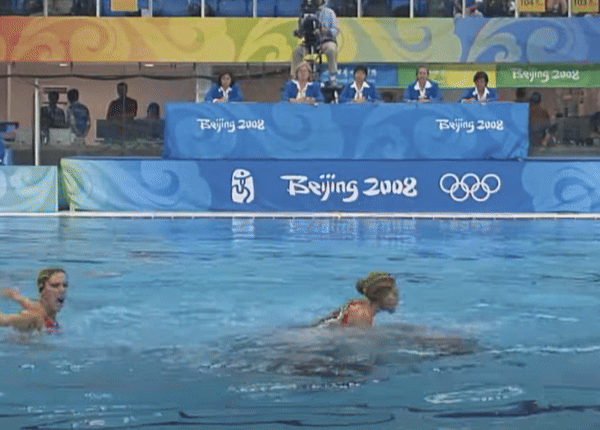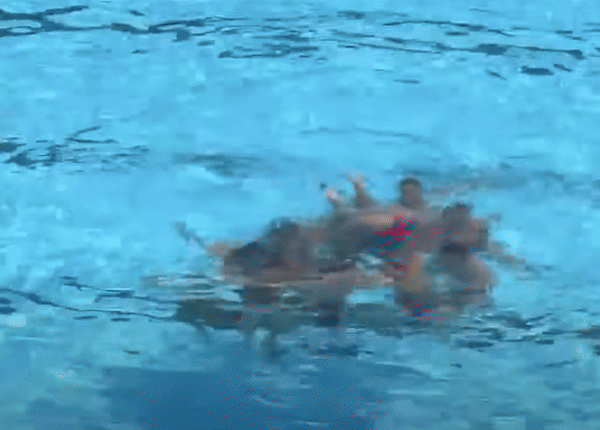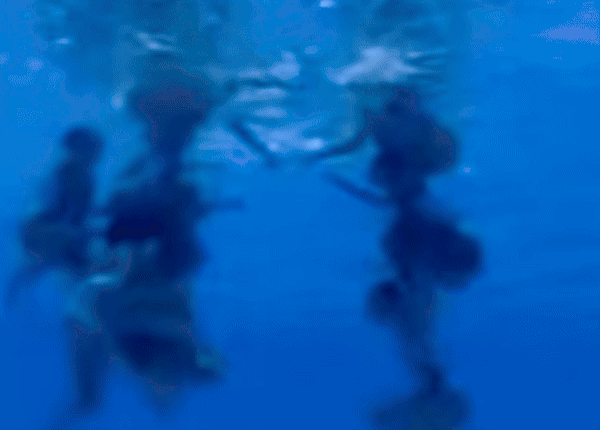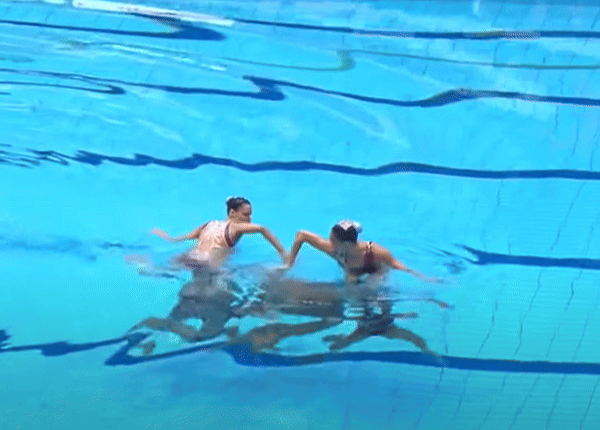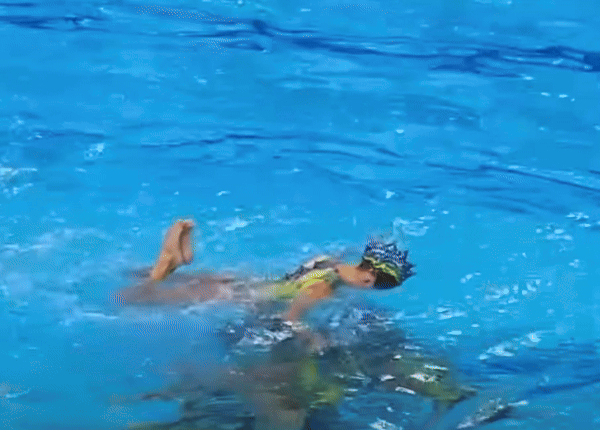If you’ve followed the 2023 season and haven’t been living under a rock, you know artistic swimming has undergone major changes to its scoring system. Now, every routine has a set number of Elements (Technical Required Elements, Free Hybrids, or Acrobatics) to be performed. Each of these Elements has a Degree of Difficulty (DD) value.
We previously dove into the DD of Free Hybrids (and the updates applied last June). In this new installment, we will focus on the Team Acrobatics and their DDs, how they are judged, and the Acrobatic Team event. Finally, we will also answer some of the most frequent questions we’ve received over the past year on that topic.
What are the different acrobatics?
In these new rules, there are two kinds of acrobatics: Team Acrobatics and Pair Acrobatics. A team acrobatic movement is considered as an Element when at least four swimmers are involved. All acrobatics must start and finish in the water.
Pair Acrobatics are exclusive to duets and mixed duets, and only have a DD in these events. In teams, they are considered as transitions. Pair Acrobatics will be covered more extensively in a future article.
A few definitions
Before we dive any further into the team acrobatics, let’s start with some important terminology that will frequently come up when discussing acrobatics:
– Featured swimmer (FS): that’s your flyer, the athlete on top that executes acrobatic movements in the air or on support.
– Support swimmer: that is the athlete in “the middle” of the construction, who could be lying down during a platform or whose shoulders will be used by the featured swimmer to jump.
– Base swimmers: the athletes who push or lift the featured swimmer, or the support swimmer with the featured swimmer on top.
– Construction of the base: the name of the coordinated actions of the athletes leading to the creation of the support from which the featured swimmer can execute acrobatic actions.
Four groups
All team acrobatic movements have been split into four main groups: A, B, P and C.
-
GROUP A – AIRBORNE
All Airborne acrobatics are performed by a featured swimmer in the air. There must be a loss of contact between the FS and the construction of the base. This group includes two subgroups: Jump and Throw.
A Jump (AJ) occurs when the featured swimmer jumps from the construction. There is a clear action of the FS contributing to the repulsion phase. This is considered a Jump.
A Throw (AW) occurs when the featured swimmer is thrown in the air by the construction of the base. The FS doesn’t do the action of jumping, there is no repulsion phase. This is a Throw.
-
GROUP B – BALANCE
Acrobatic movements in this group are performed on a support or a base with the aim of reaching a maximum height far from the surface of water, with no loss of contact between the FS and the construction. It includes two subcategories: Stack and Lift.
A Stack (BS) occurs when the featured swimmer sits/stands/lays on support swimmer(s) who is/are in a vertical body position (head up or head down). This is a Stack. This is a Stack with spotters (swimmers who help with balance).
A Lift (BL) does not feature a support swimmer. It occurs when the featured swimmer sits/stands/lays on base swimmer(s), and the former must be lifted up and away from the water’s surface for the entire movement to be considered a lift. This is an example of a Lift.
-
GROUP P – PLATFORM
This group includes acrobatics that require the coordinated effort of team members to form a stable support on which one or more swimmers is lifted to pose or perform actions close to the surface of the water. It includes two subcategories: Standard and Float.
A Standard platform (PP) is what we saw for many many years in the sport. It occurs when the base swimmers lift from underwater a support swimmer in a horizontal position, and on which the featured swimmer sits/stands/lays. This is classified as a Standard Platform.
A Float (PF) doesn’t have a support swimmer, but rather happens due to the coordinated action of multiple base swimmers forming a stable geometric figure on which the featured swimmer can execute movements. For example, this is a Float.
-
GROUP C – COMBINED
As its name indicates, this encompasses the characteristics of the other three groups. It includes three subcategories: Onto Support, Through Support, and Other.
An acro that falls under Combined Onto Support (CC) is when the featured swimmer jumps from one formation onto another, and remains on that second one until it submerges. This is Combined Onto Support.
A Combined Through Support (CT) acro is when the featured swimmer jumps and passes through other formations. There’s only a slight touch, the featured swimmer keeps moving. This is a Combined Through Support.
Finally, the Combined Other (CO) subgroup encompasses all acrobatic movements that do not fit anywhere else. This is an example of a Combined Other acrobatic, as it is essentially a half throw, half stack.
What’s in a DD of an acrobatic movement?
Every part of any acrobatic movement in each group has been dissected, attributed a value and a code to essentially arrive at an acrobatics nomenclature.
It does slightly vary by group but overall, the Degree of Difficulty of an acrobatic takes into account:
- The Construction of the acro
- The Position(s) shown by the featured swimmer
- The Direction of the movement (Groups A & C only)
- The Area of Support / Type of connect (Groups B & P only)
- The Rotation of the construction’s base (Groups B, P & C)
- The Plane and Degree of Rotation, using the letter T (Groups A & C only)
- Any other Bonuses
The overall DD is simply the addition of these categories. For example, the DD of an acro in Group A will be equal to C + P + D + T + B. In Group B, it would be C + P + S + R + B.
Each main group and subgroup has its own kinds of constructions, positions, directions, types of connections, etc. Once again, everything has been studied, cataloged, codified, and attributed a value. In the end, every acrobatic movement will have its own code and value. You can check out the Acrobatics Catalogue Quick Reference Sheet to get a better understanding of what’s behind an acro code, or to have fun constructing your own.
Fans or casual viewers theoretically will never face or need to decipher any acrobatics codes during a competition. But let’s still have a quick look at a few examples of what it looks like on a Coach Card:
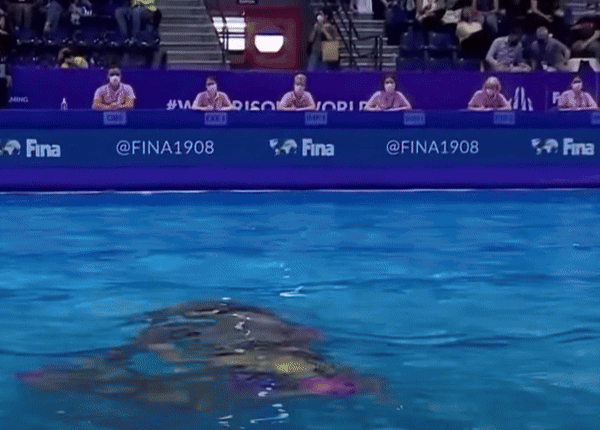
AJ-Sq-Back-tk-s2
This is an acrobatic movement from the Airborne – Jump group.
It starts from a Square (“basket”) construction, the featured swimmer goes in the Backwards direction, in the tuck position, and does a double somersault (s2).
DD = C + P + D + T = 1.35 + 0.1 + 0.1 + 0.6 = 2.15
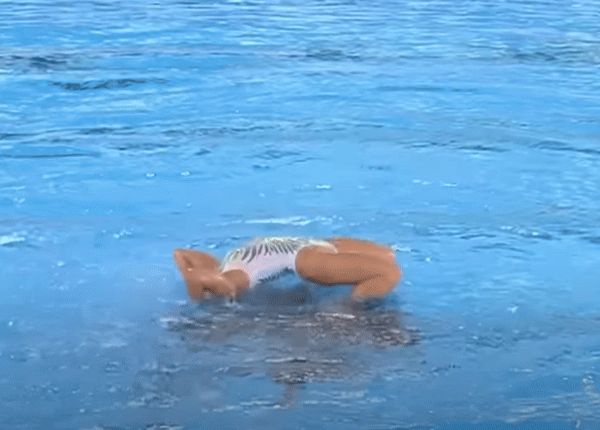
PP-DB-PF+FP-br
This is an acrobatic movement from the Platform – Standard (PP) group.
Its construction is a platform with Double Ballet leg support, featuring a Palms on Feet+Feet on Palms bridge.
DD = C + P + S = 1.4 + 0.45 + 0.4 = 2.25
How are team acrobatics judged?
When judging team acrobatics, judges look at different criteria: height, whether it was a clearly defined and recognizable action (accuracy of positions, body extension, control, direction, water entry, etc.), stability in achieving and maintaining the positions, and minimal set-up and recovery time.
Height determines the execution range for all groups, and can be considered as a “starting point”, or a ceiling, in determining the final execution score. Each acrobatic group has different height scales. In Group A and B, those height scales are further split into two: one scale for big acrobatics (when the construction consists of seven or more athletes), and one for small acrobatics (when the construction consists of four to six swimmers).
Each height scale is adapted to its group and the construction of its acros. For example in Group A, judges consider the height of the FS in relation to the surface of the water, and visually estimate how many “full bodies” could fit within that jump amplitude. On that height score, execution deductions may then be applied as well, for example if the FS ends up too close to the structure or if the water entry is messy.
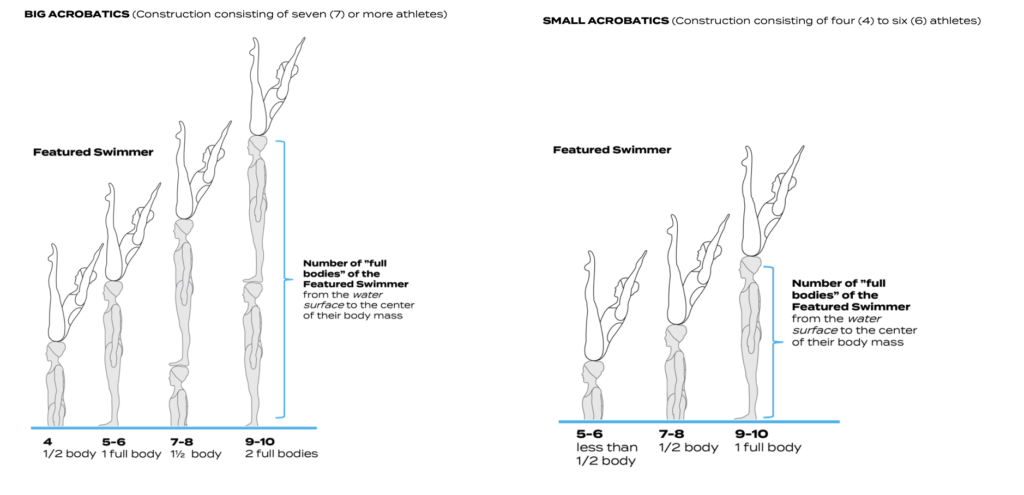
When judging the direction of Airborne acrobatics, there is also a deduction of up to two points if the acro is not safe enough, meaning when the FS lands too close to the construction or impacts it. It is desirable to leave at least one meter between the construction and the landing area of the FS.
In Group B and P, judges will instead look at the height of the support swimmer, if there is one, and how far out of the water they get depending on the position they are in. This applies to stacks (BS) and standard platforms (PP). If there is no support swimmer, so in the case of lifts (BL) and floats (PF), the judges directly look at the construction that holds the acro.
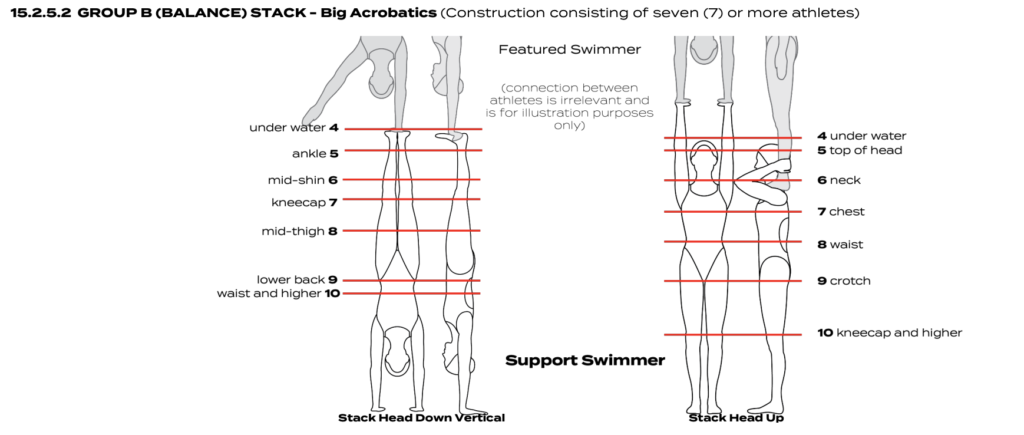
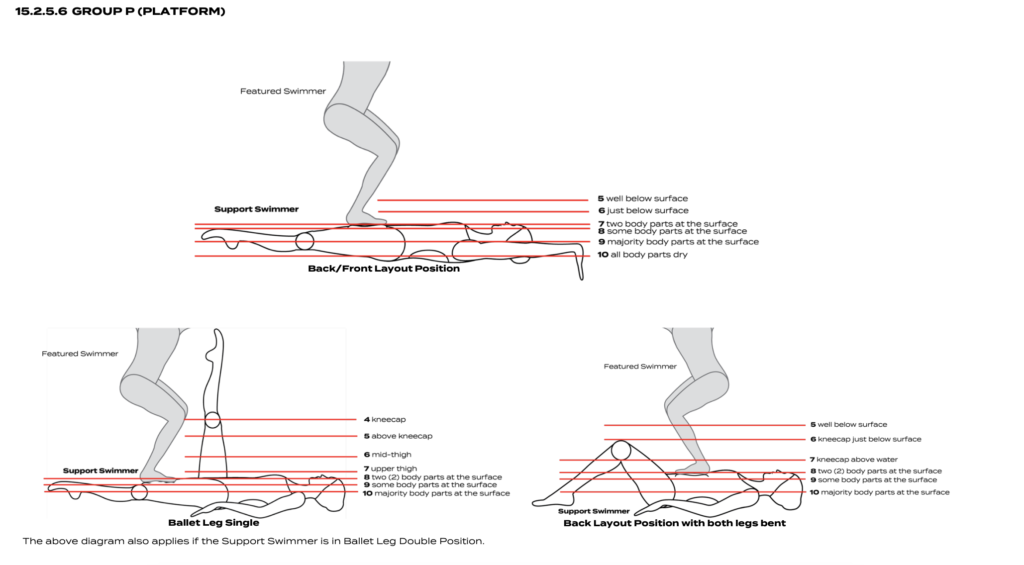
In Group C, the applicable height chart is based on the type of acrobatics in the main (bigger) formation (platform, stack, etc.) of the construction.
Here are some examples of what judges should look at to judge height in Combined acros:

If an acrobatic movement is attempted but does not surface, is considered as a complete failure, or if it is unclear which acrobatics was intended, the Elements judges will score low but nothing under 3.0, which is the minimum score.
Finally, and just like for Free Hybrids, if a team does not perform the acrobatic movement exactly as declared on the Coach Card, it will not be credited its full difficulty, but will rather receive a basemark of 0.5 from the Difficulty Technical Controllers.
It is however not always so black-and-white, and there are certain allowances in place to determine whether an acrobatic movement should receive a basemark or “only” a major deduction. As a general principle, the limit of the tolerance for basemarks results in a big deduction. We will discuss that topic in the Q&A section further down.
The Acrobatic Team Routine
In 2023, the Acrobatic Team event replaced what was known as the Highlight event, and continued to strongly emphasize the acrobatics in artistic swimming. So much so that, in fact, acrobatics are all that counts towards the total DD of that routine. Hybrids can be performed in these routines, but will not receive any difficulty value. They will only be judged by the artistic impression panel.
In this routine, seven acrobatics are required and at least one from each group must be featured. That means four acrobatic movements will consist of one Airborne, one Balance, one Platform and one Combined. The remaining three are free choices.
Teams can do the same acrobatic movement twice in the routine if they want to. While it takes away a bit of the fun for the audience, they will not receive any penalties for it. They may however get deducted for lack of variety by the artistic impression panel.
The Acrobatic Team routines are judged just like any other routines. The Elements judges look at the execution of each Element performed (in this case, solely the acrobatics), while the artistic impression panel looks at the choreography and musicality, the performance, and the transitions in the routine. The Difficulty Technical Controllers check that every acrobatic movement declared on the Coach Card matches what is being performed in the water. And finally, the Synchronization Technical Controllers register the number and type of synchronization errors observed.
Lasting three minutes, acrobatic team routines are only performed in the junior and senior categories. They were recently added to the Olympic programme for 2024.
Q&A
-
When is it a basemark and when is it “only” a large deduction?
The featured swimmer enters the water with a belly flop after their somersaults and yet, that acro doesn’t receive a basemark. A stack acro falls over sideways as it’s turning, but is credited with its full DD. Or on the contrary, an acrobatic movement that seemed great, high and very cleanly executed, receives a basemark. It has happened multiple times last season and certainly, it can get puzzling.
Firstly, keep in mind that declaring and judging are two different worlds. An acro receives a basemark when it is not performed as declared on the Coach Card, no matter how well or poorly it was executed. And vice-versa.
Unfortunately, no one but the technical controllers has access to the Coach Cards, so often, the precise reason for the basemark is not so obvious. The coach could have made a mistake in writing down the correct code, or the swimmers might have missed a turn, a position, or a movement. So, it might have looked great, but what was done in the water did not match what was on the paper: basemark. Conversely, the stack was unstable during a turn but still completed it fully: no basemark.
With acrobatics, and especially those of the Airborne group, the question of “basemark or not basemark” is however not always so straightforward. Consequently, allowances have been implemented related to the completion of rotations in somersaults and twists.
For somersaults, if the jump is underrotated by 90° or more, then it will receive a base mark. Let’s imagine the team declared a double back somersault, so a 720° rotation. If the FS shows a rotation of 650° and then belly flops into the water, the team will not receive a basemark. It should however receive a large execution deduction by the judges for the messy water entry. However if the FS only manages a 540° rotation (one and a half somersault), then the acro will go to basemark, no matter how clean or splashy the entry was.
On the contrary, over rotations are fine. So in our example, if the FS rotates 800° or even 1080°, it is tolerated since the double somersault was ultimately shown fully above the water. Naturally, the team will not receive any extra credit for doing a triple back instead of a double, but may receive execution deductions as normal.
Twists have similar allowances for under rotations. For 360° rotations, an allowance of 180° is tolerated. So, if a team declares a 360° twist but the FS shows 170°, it will go to basemark. If the FS only manages 270°, the acro will get credited its DD.
For 180° rotations, the allowance is 90°. Meaning if a team declares 180° and the FS only manages 80°, it will go to basemark. Just like for somersaults, over rotations will not be penalized.
-
Is it possible to innovate and create a new acrobatic movement?
Yes. Teams can submit new acrobatics, movements, positions, constructions, areas of support, etc., to World Aquatics. They will look into it and, if approved, attribute it a code and a value based on their algorithm. The existing catalogue is already incredibly extensive, but in constant evolution and not set in stone.
At this point, it appears more advantageous for countries to build their acros with what already exists, rather than starting from scratch and trying to come up with new positions and never-before-seen acrobatics. For example, it is better to maximize the DD by adding a half twist here, a 180° rotation there, or change the structure of the construction from one to two ballet legs, for example.
-
Is there a limit to the difficulty of acrobatics in each age group?
Yes. There is a difficulty cap in place for the Under-12 and Youth (13-15) age groups. Their acrobatics cannot have a DD higher than the following: Group A: 2.65, Group B: 2.60, Group P: 2.50 and Group C: 2.45.
These age groups do not compete in the acrobatic team event, but still do have to perform three to four team acrobatics in both the free team routine and the free combination routine.
There are also limits in the technical team routine for the juniors and senior categories. For this routine, the DD for the acrobatic movement must not be less than 2.0 nor exceed 2.65.
-
What is the acrobatic movement with the highest DD?

At the time of this writing, the acrobatic movement with the highest DD was successfully performed by Mexico at the Pan American Games. This platform (PP) received a DD of 3.65.

ARTICLE BY CHRISTINA MARMET
Cover photo: Deepbluemedia
If you’ve enjoyed our coverage, please consider donating to Inside Synchro! Any amount helps us run the site and travel costs to cover meets during the season.

